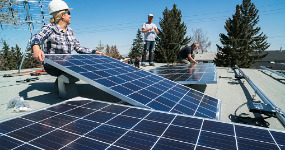In May, the Canada Pension Plan Investment Board committed €200 million to renewable energy projects in France; and in September, the Canadian government announced a $9.4-million investment in four tidal energy projects that will bring clean energy technologies to the Atlantic region.
Renewables are becoming more prominent as green technology enters the mainstream and concern over environmental pollution and global warming stay top of mind. That growth will continue, including a demand for more energy storage, say lawyers who work in the sector.
“There’s a long history in all of the provinces, especially Ontario, Quebec and B.C., of hydro power” or electricity generated by water, says Krista Hill, a partner at Torys LLP in Toronto. But, starting from around 2000, there was a more focused interest in renewables such as wind and solar, and governments across Canada set up programs for developing those projects.
Power is a provincial head-of-power constitutionally, so what happens in each province is different; Ontario and Quebec have taken the lead there, Hill says, in setting up numerous programs, which have included “a huge amount of wind and solar development in Ontario.”
“There’s been huge growth” from around 2003, she says, with thousands of megawatts installed across Canada in wind and solar projects, as well as biomass projects in certain jurisdictions over the past few years. Biomass is another fuel source used to generate electricity; for example, methane gas released from a landfill and captured.
“Going forward, there are a huge number of projects and policies to set up and facilitate renewable projects,” says Valerie Helbronner, a partner at Torys LLP in Toronto. Although activity has slowed down in the past number of years owing to policy reasons and demand reduction, in part due to COVID-19, and “we don’t see a huge number of projects currently being built, [with] the focus on climate change initiatives and decarbonization, we can certainly expect that renewables will very much be a part of any of those initiatives.”
A key trend to watch for, she says, is in wind and solar power, which have reached price parity. In the early 2000s, those technologies were seen as more expensive, “but because of advances and the number of players involved in the industry and the passage of time, we’re seeing those technologies being competitive. We can expect that all renewable technologies will be part of the climate change plan going forward.”
Greenfields development is diminishing as many government procurement programs have run their course, leaving it to the private sector to reduce the carbon footprint, says Anthony Spadaro, a partner in the energy practice at Davies Ward Phillips & Vineberg LLP in Toronto.
“Carbon pricing has provided some impetus for heavy emitters to seek carbon offsets” and the like, he says.
Across Canada, the NDP government in British Columbia has indicated it doesn’t “like independent power producers very much,” Spadaro says, and it introduced legislation that has eliminated the requirement for B.C. Hydro to be self-reliant. “What B.C. will likely do is increase imports from other jurisdictions like California.”
In Alberta, the Conservative government elected last year scrapped the Renewable Electricity Program last year, but the province is seeing early-stage proliferation of purchase price allocation agreements recently: a type of synthetic power purchase agreement whereby the business that wants to procure the renewable energy enters into a contract with a generator, which fixes the contract price for the business that’s interested in procuring the green energy.
“We could see a number of new projects developed that way.”
Canada has indicated it wants to be free of coal by 2030, although Alberta, Saskatchewan and to a lesser extent New Brunswick rely heavily on it. Alberta will predominantly be using natural gas and is currently building “a massive 900-megawatt combined cycle gas plant,” which, when completed in 2023, will represent about eight per cent of Alberta’s electricity.
Saskatchewan is putting out an RFP for 300 megawatts of wind power, says Spadaro, with the successful candidates to be announced in 2021.
In Ontario, he says, ”the Ford government has made it clear that they blame the green contracts signed by the McGuinty government” for the province’s high hydro rates, and it scrapped the White Pines project after it was elected, “so it’s unlikely you’ll see greenfield procurement under [Premier] Doug Ford,” who may also have “a tough time fulfilling his election promise to reduce hydro rates” under contracts signed a long time ago.
Demand for energy storage — or what are called distributed energy resources — has increased, says Thomas Timmins, leader of Gowling WLG Canada's Energy Sector Group, in Toronto. Natural resources and energy storage costs are plummeting, he says. Solar energy has followed patterns similar to computing technology whereby the cost per kilowatt-hour is going down by half every few years, making procurement for solar competitive.
“The technology has moved so quickly,” he says, “and it’s at the grid edge that technology is most economical.” For a customer at the end of a Hydro One line in a remote community or far-flung cottage country, “it might become economical for you to put solar on your roof before someone in Toronto does it. In many cases, it’s cheaper to take down the power line and put in a solar solution.”
Commercial and industrial solar energy is becoming popular, and even in urban Ontario, people are putting solar panels on the roof of a factory to stabilize energy costs. Many industrials and those in the municipalities, universities, schools and hospitals sectors are also using batteries to shave their peak load, relying on both hydro and battery power, he says.
“It’s a multiplicity of choices people have.”
As for trends in renewables construction, Timmins says he is seeing “all kinds of new innovations in [power] generation. In solar, all kinds of new materials are being used to squeeze more energy out of the panel.” New materials are also being used for energy storage, and different metals and system layouts are being used to reduce costs, improve reliability, enhance battery life and make batteries function in minus-40C weather.
Artificial intelligence is also being applied to the operation of the grid. There were 50 big energy plants in Ontario at one time, but we’re not in a world where we have one million or two million individual energy plants, including solar panels and solar garden lights, all feeding into the grid, says Timmins, and all interconnected, from Florida to James Bay.
“There’s a lot going on, and the public is largely unaware” of it, he says.
Many Indigenous communities have an interest in renewables projects or own them, he says, adding that his firm acted on the Pattern Energy wind farm development on behalf of the First Nation on that project. First Nations communities not connected to the grid are relying on diesel and want to reduce that reliance.
“Good things are happening and have happened.”
And the role that Indigenous groups play in those projects extends beyond the renewable energy sector, says Helbronner. “In any infrastructure project, the role of Indigenous peoples within those projects will be fundamentally important. There’s often an alliance of values and interests in terms of what renewable energy projects represent and a real opportunity for remote communities in terms of having renewables assist them with their energy needs.”
Many regulatory changes are also taking place, says Timmins, and changes were made last year to the Income Tax Act regarding accelerated capital cost depreciation to solar.
The Independent Electricity System Operator of Ontario is working through a regulatory regime for grid-connected solar and is constantly seeking input on how to make the rules fair, he adds, and to compensate individuals who sell their power back into the grid, as well as working on demand-response technologies.
“We have lots of capacity in the system, which is great until a global pandemic hits and you have a hot day in July,” Timmins says. “When demand on electricity reaches 95 per cent of capacity, people at the IESO start to worry. We need some communities [who have signed on as volunteers, possibly a factory, college or university or water-pumping station] we can shut down for a few hours at a time, and the economic incentive is there to use less electricity.
“That’s a new area that’s growing in Ontario, but [it] requires contract drafting and complex legal thinking at the end of the day.”
COVID-19 has created a “fluid” situation and “an obscene reduction in demand” for energy, says Helbronner. “But, on the other hand, you very much see at the federal level a focus on economic stimulus and a real focus on climate change.”
Although there may be some reduction in renewable energy projects, “the needs for energy supplies can change quickly, and from a policy perspective, the existing federal government is very focused on climate change. I think that there's going to be some real opportunities for the renewable energy sector in terms of responding to climate change policies and initiatives going forward.”





